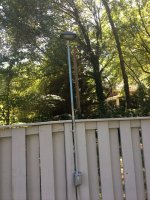Orion7319
Bronze Supporter
- Jul 1, 2020
- 1,442
- Pool Size
- 19775
- Surface
- Vinyl
- Chlorine
- Salt Water Generator
- SWG Type
- Hayward Aqua Rite (T-15)
I have had to pull plenty of wires and repair plenty of leaky pipes in walls or ceilings. Patching drywall is easy, what really stinks is when you can’t get a good paint match to the existing wall paint and wind up having to repaint an entire room. Yes always prime, for fresh drywall mud you don’t need the expensive primer the cheap stuff will do just fine. Also I personally don’t use fix it all or quick drying mud. I just use the regular stuff and dry each layer of mud with a heat gun. I find that using a heat gun makes for quicker dry times then about anything else.The trick to the patching is to not use sheetrock tape. That ends up needing a lot of layers of mud, and sanding and smoothing and blending... a 6"x6" hole becomes a 2'x2' patch, that'll take three or four days of drying, too! And a huge mess! My miracle material is Fix-It-All. It used to be called Fix-All. It's a spackling compound that dries like rock. So:
You use a sheetrock saw and carefully cut out the square. Smaller isn't better, because you have to get your hand in there, or a drill. Don't be shy. I'll cut out as big as I need to work comfortably. I'll save the cut out. When cutting through a wall, you have to be careful towards the end so that you don't lose the piece down the inside of the wall!
Come patch time, I'll cut two pieces of soft wood, a few inches longer than the patch is wide. So for a 6x6 hole I'll cut two 10" long pieces of wood. 1"x2" pine works great. I'll screw a sheetrock screw into the middle of flat side of each piece. That's a handle. Then I'll work the piece into the hole, and use the screw handle to pull the wood up tight to the back of the sheetrock. If the hole is big enough, you don't need the handle, you can just use your fingers to pull it tight. Then you screw through the sheetrock to fix the wood to the back of the sheet rock. Do that with the second piece. Now you can screw the patch to the wood and that will flush it up nicely with the wall. Mix up some Fix-It-All and smoosh it into the joints, smooth and flush with the wall. Don't leave any beads sticking out, as they are very hard to sand. Let that dry. Only takes a half hour or so.
That'll seal up the patch to the wall. Fix-It-All won't crack or shrink. It's stronger than the gypsum inside the sheetrock, and sticks to it permanently. I've never had one of these patches fail or later reveal. I've done it hundreds of times. Then you might need a light coat or two of mud over that, to just smooth over the Fix-It-All. Some light sanding between coats and you'll end up with a super smooth wall. Undetectable. Add texture to match the existing wall, prime and paint (don't skip the priming, it's not worth it). I can usually do all that in one day, with some hours between coats, depending on weather and how thick I had to coat things.



